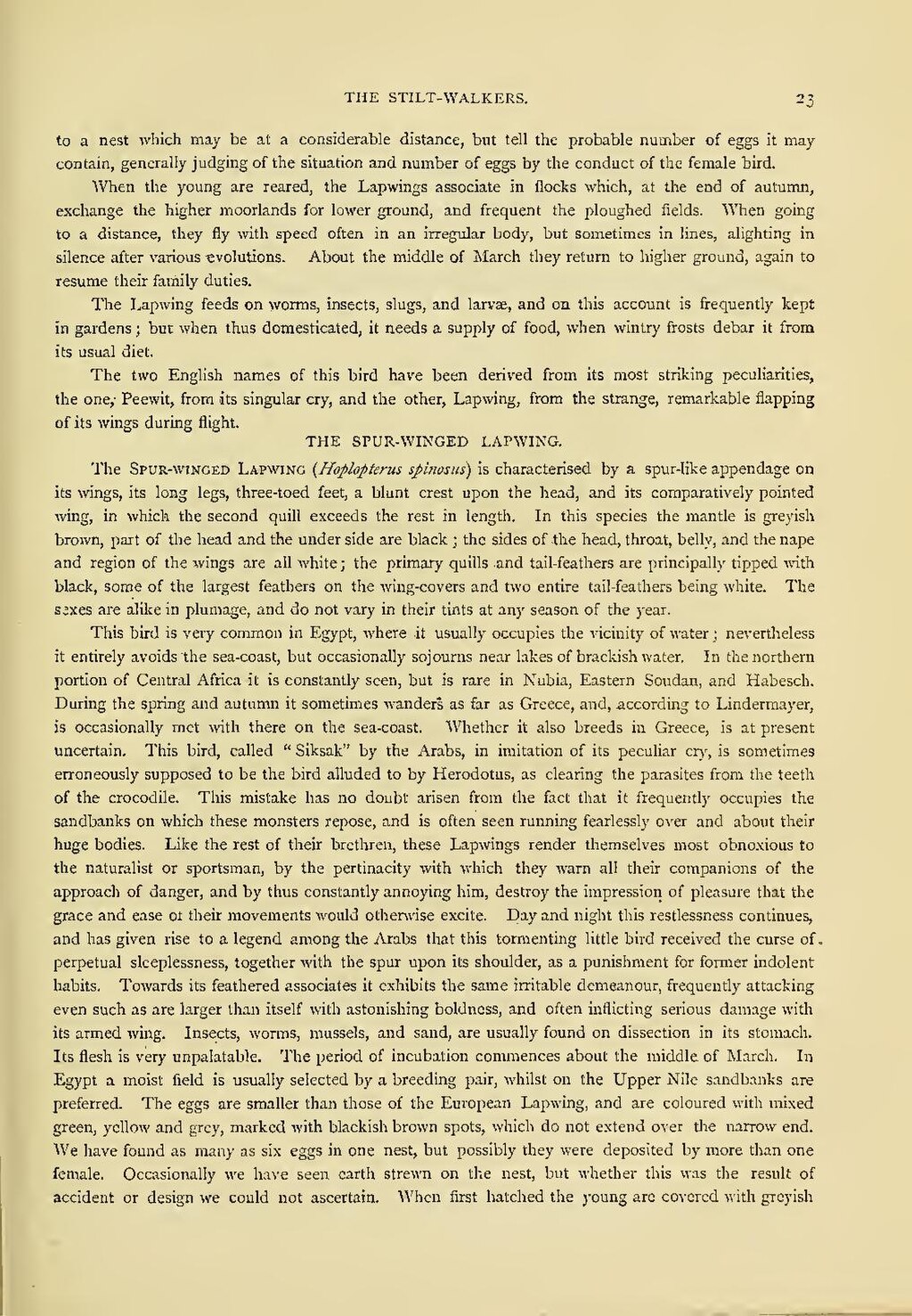to a nest which may be at a considerable distance, but tell the probable number of eggs it may contain, generally judging of the situation and number of eggs by the conduct of the female bird.
When the young are reared, the Lapwings associate in flocks which, at the end of autumn, exchange the higher moorlands for lower ground, and frequent the ploughed fields. When going to a distance, they fly with speed often in an irregular body, but sometimes in lines, alighting in silence after various evolutions. About the middle of March they return to higher ground, again to resume their family duties.
The Lapwing feeds on worms, insects, slugs, and larvæ, and on this account is frequently kept in gardens; but when thus domesticated, it needs a supply of food, when wintry frosts debar it from its usual diet.
The two English names of this bird have been derived from its most striking peculiarities, the one, Peewit, from its singular cry, and the other, Lapwing, from the strange, remarkable flapping of its wings during flight.
THE SPUR-WINGED LAPWING.
The Spur-winged Lapwing (Hoplopterus spinosus) is characterised by a spur-like appendage on its wings, its long legs, three-toed feet, a blunt crest upon the head, and its comparatively pointed wing, in which the second quill exceeds the rest in length. In this species the mantle is greyish brown, part of the head and the under side are black; the sides of the head, throat, belly, and the nape and region of the wings are all white; the primary quills and tail-feathers are principally tipped with black, some of the largest feathers on the wing-covers and two entire tail-feathers being white. The sexes are alike in plumage, and do not vary in their tints at any season of the year.
This bird is very common in Egypt, where it usually occupies the vicinity of water; nevertheless it entirely avoids the sea-coast, but occasionally sojourns near lakes of brackish water. In the northern portion of Central Africa it is constantly seen, but is rare in Nubia, Eastern Soudan, and Habesch. During the spring and autumn it sometimes wanders as far as Greece, and, according to Lindermayer, is occasionally met with there on the sea-coast. Whether it also breeds in Greece, is at present uncertain. This bird, called "Siksak" by the Arabs, in imitation of its peculiar cry, is sometimes erroneously supposed to be the bird alluded to by Herodotus, as clearing the parasites from the teeth of the crocodile. This mistake has no doubt arisen from the fact that it frequently occupies the sandbanks on which these monsters repose, and is often seen running fearlessly over and about their huge bodies. Like the rest of their brethren, these Lapwings render themselves most obnoxious to the naturalist or sportsman, by the pertinacity with which they warn all their companions of the approach of danger, and by thus constantly annoying him, destroy the impression of pleasure that the grace and ease of their movements would otherwise excite. Day and night this restlessness continues, and has given rise to a legend among the Arabs that this tormenting little bird received the curse of perpetual sleeplessness, together with the spur upon its shoulder, as a punishment for former indolent habits. Towards its feathered associates it exhibits the same irritable demeanour, frequently attacking even such as are larger than itself with astonishing boldness, and often inflicting serious damage with its armed wing. Insects, worms, mussels, and sand, are usually found on dissection in its stomach. Its flesh is very unpalatable. The period of incubation commences about the middle of March. In Egypt a moist field is usually selected by a breeding pair, whilst on the Upper Nile sandbanks are preferred. The eggs are smaller than those of the European Lapwing, and are coloured with mixed green, yellow and grey, marked with blackish brown spots, which do not extend over the narrow end. We have found as many as six eggs in one nest, but possibly they were deposited by more than one female. Occasionally we have seen earth strewn on the nest, but whether this was the result of accident or design we could not ascertain. When first hatched the young are covered with greyish
